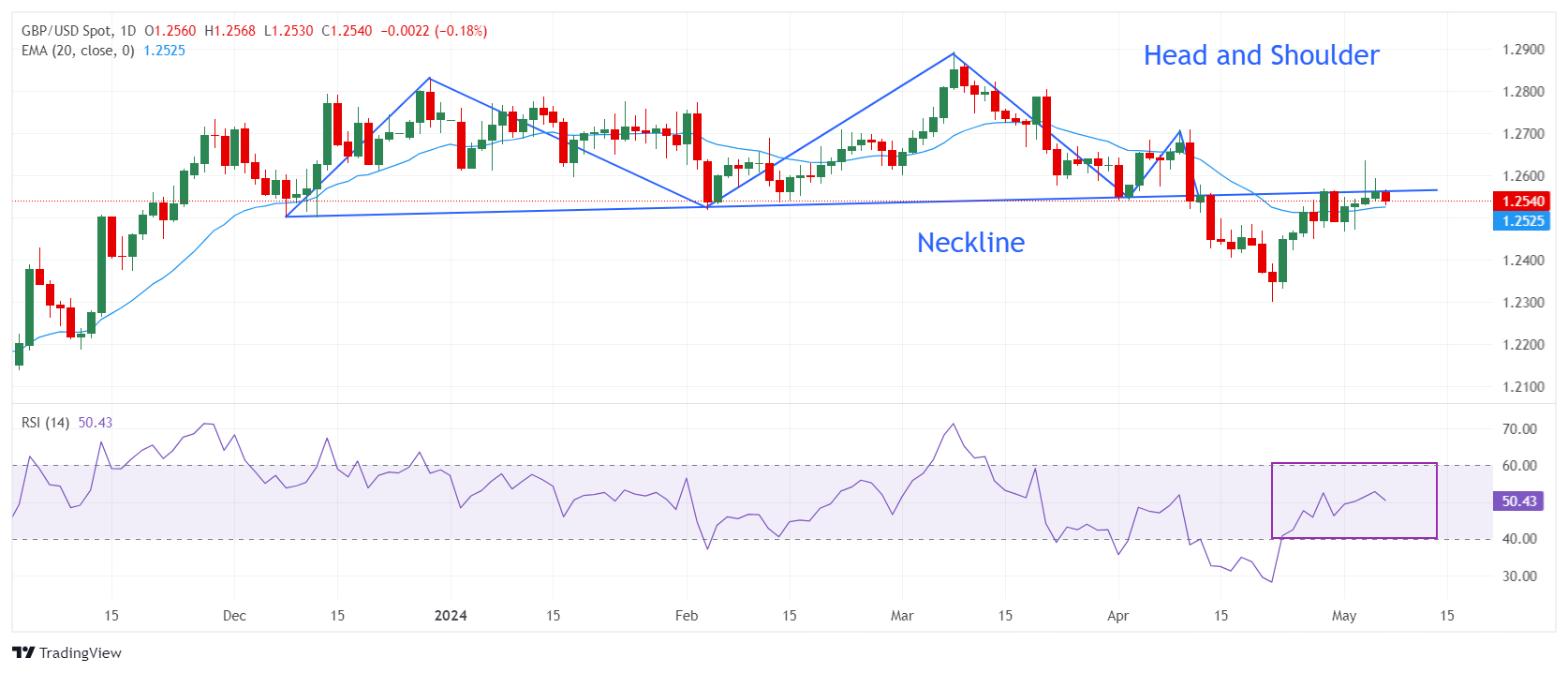- The Pound Sterling falls to 1.2540 as investors see the BoE easing interest rates before the Fed does so.
- UK interest rates are expected to remain steady at 5.25% for a straight sixth time after Thursday’s BoE meeting.
- Investors see the BoE beginning to reduce interest rates from August.
The Pound Sterling (GBP) dropped to 1.2540 against the US Dollar in Tuesday’s early American session. The GBP/USD falls as the US Dollar extends its upside, with the US Dollar Index (DXY)—which tracks the Greenback’s value against six major currencies—moving higher to 105.25.
Investors seem to remain confident about the United States’ economic outlook despite the recent weakness seen in a slew of economic data such as lower labor demand, slower wage growth and contracting Services PMI in April. The overall good performance of the economy will allow the Federal Reserve (Fed) to take its time to cut interest rates compared with other central banks from developed nations.
Still, weak US economic data has fuelled expectations for the Fed to reduce interest rates from the September meeting. Uncertainty prevails over the Fed’s rate-cut timing as policymakers see the current monetary policy framework as adequate. On Monday, New York Fed Bank President John Williams said: “Eventually we’ll have rate cuts”, but for now, monetary policy is in a “very good place,” Reuters reported.
Daily digest market movers: Pound Sterling falls with eyes on BoE policy meeting
- The Pound Sterling falls sharply after facing significant selling pressure near the round-level resistance of 1.2600. The GBP/USD pair weakens as investors remain convinced about the chances that the Bank of England will reduce interest rates earlier than the Fed.
- Financial markets anticipate that the BoE will start reducing rates in August and that the Fed will do so in September. This is consistently supporting the US Dollar despite the miss in the Nonfarm Payrolls (NFP) and the Services PMI data for April.
- Investors will get more clarity on the UK interest rate outlook from the BoE’s monetary policy decision, which will be announced on Thursday. The BoE is widely expected to keep interest rates steady at 5.25% for the sixth straight time. Therefore, any commentary on the interest rate outlook will be more useful for investors to predict the next move in the Pound Sterling.
- BoE Governor Andrew Bailey said last month that he is hopeful for the headline inflation to return to the desired rate of 2% in April. Also, in the last monetary policy meeting, he said he was comfortable with market expectations of two or three rate cuts for this year.
Technical Analysis: Pound Sterling drops from 1.2600
The Pound Sterling falls from 1.2600 but consolidates in a tight range around 1.2550. The near-term outlook of the Cable appears to be uncertain as it has not stabilized above the 20-day Exponential Moving Average (EMA), which trades around 1.2520.
The GBP/USD pair faces selling pressure near the neckline of the Head and Shoulder chart pattern formed on a daily time frame. On April 12, the Cable recorded an intense sell-off after breaking below the neckline of the H&S pattern, which is plotted from December 8 low around 1.2500.
The 14-period Relative Strength Index (RSI) oscillates in the 40.00-60.00 range, suggesting indecisiveness among market participants.
Risk sentiment FAQs
In the world of financial jargon the two widely used terms “risk-on” and “risk off” refer to the level of risk that investors are willing to stomach during the period referenced. In a “risk-on” market, investors are optimistic about the future and more willing to buy risky assets. In a “risk-off” market investors start to ‘play it safe’ because they are worried about the future, and therefore buy less risky assets that are more certain of bringing a return, even if it is relatively modest.
Typically, during periods of “risk-on”, stock markets will rise, most commodities – except Gold – will also gain in value, since they benefit from a positive growth outlook. The currencies of nations that are heavy commodity exporters strengthen because of increased demand, and Cryptocurrencies rise. In a “risk-off” market, Bonds go up – especially major government Bonds – Gold shines, and safe-haven currencies such as the Japanese Yen, Swiss Franc and US Dollar all benefit.
The Australian Dollar (AUD), the Canadian Dollar (CAD), the New Zealand Dollar (NZD) and minor FX like the Ruble (RUB) and the South African Rand (ZAR), all tend to rise in markets that are “risk-on”. This is because the economies of these currencies are heavily reliant on commodity exports for growth, and commodities tend to rise in price during risk-on periods. This is because investors foresee greater demand for raw materials in the future due to heightened economic activity.
The major currencies that tend to rise during periods of “risk-off” are the US Dollar (USD), the Japanese Yen (JPY) and the Swiss Franc (CHF). The US Dollar, because it is the world’s reserve currency, and because in times of crisis investors buy US government debt, which is seen as safe because the largest economy in the world is unlikely to default. The Yen, from increased demand for Japanese government bonds, because a high proportion are held by domestic investors who are unlikely to dump them – even in a crisis. The Swiss Franc, because strict Swiss banking laws offer investors enhanced capital protection.
منبع: https://www.fxstreet.com/news/pound-sterling-falls-back-as-focus-shifts-towards-boe-monetary-policy-decision-202405070740
